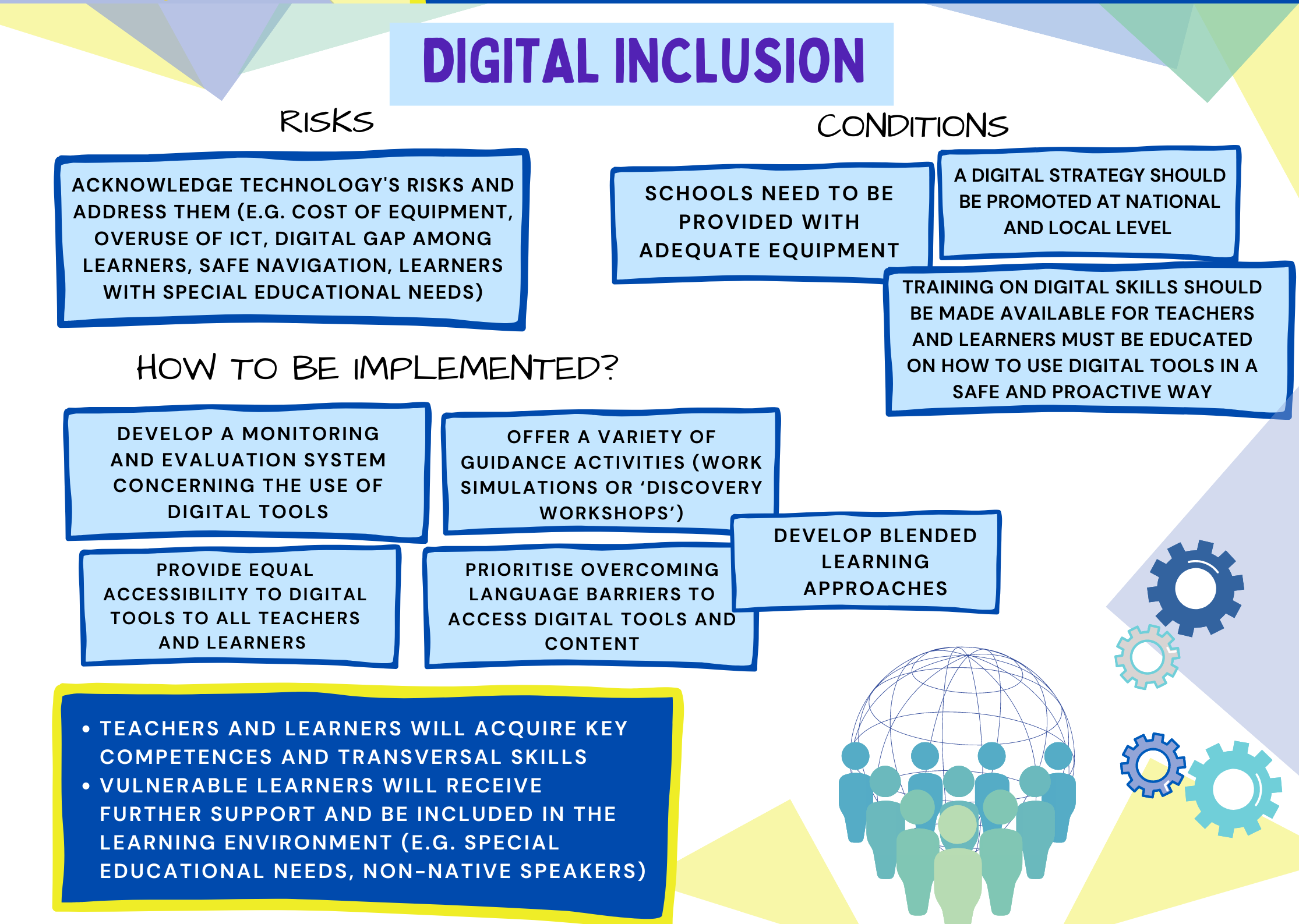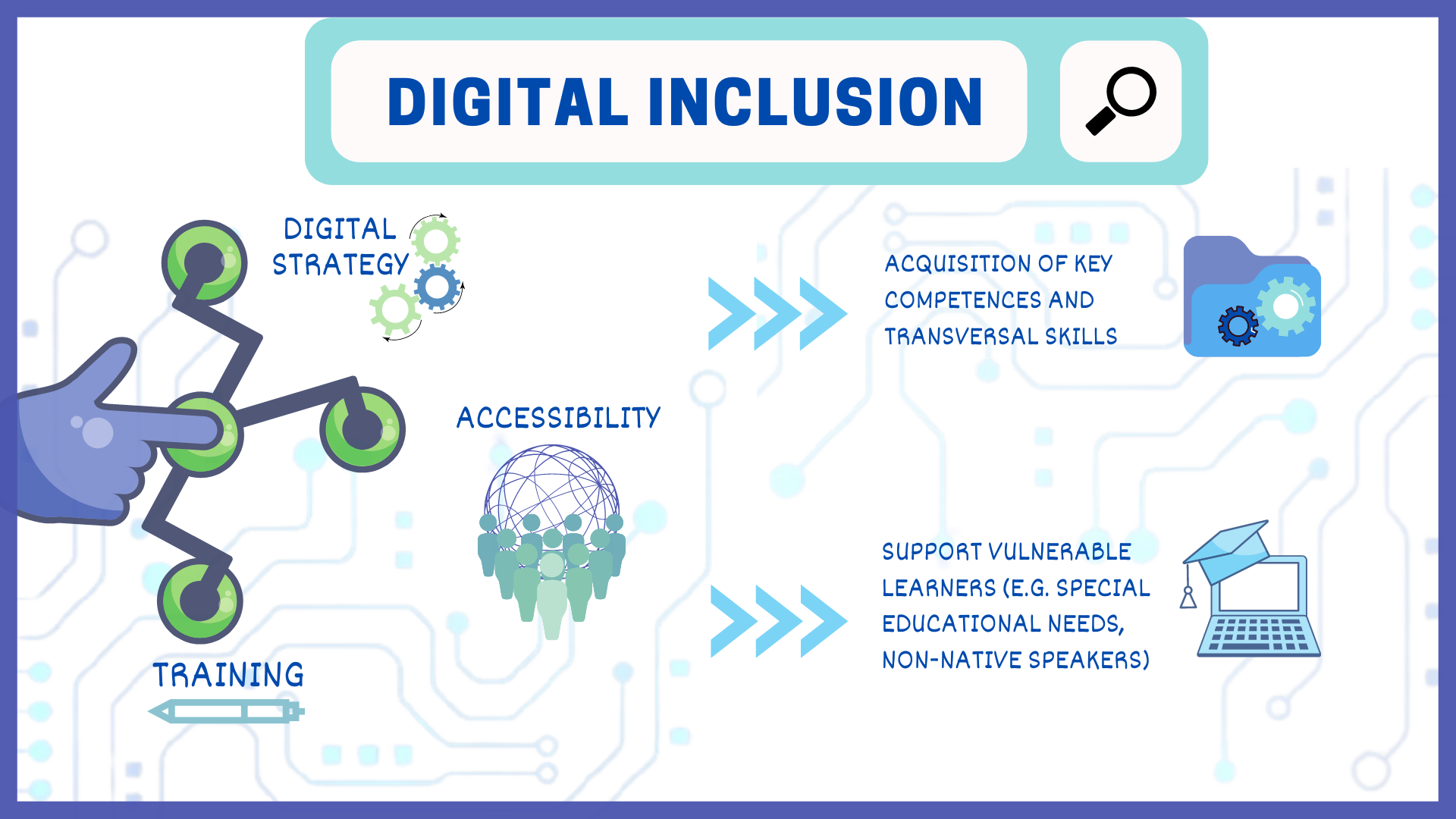Problem statement
Addressed problem: integrate and bolster digital tools in VET system
Technology has not been yet effectively integrated into teaching practice across Europe. The use and effectiveness of digital tools varies widely across member states and across different school environments. The stark digital divide and education inequity have worsened with Covid-19 measures, as most learning practices shifted to distant methods and online tools were swiftly adopted. In a context where digital devices and internet access increase, it is becoming more and more obvious that digital exclusion may lead to professional and social exclusion.
Digital education strategies have typically been designed with all learners in mind, without sufficient attention to the specific barriers faced by marginalised learners or groups. On the other hand, inclusive education measures have not always included a clear ‘digital’ dimension. For this reason, it is necessary to link the aspect of digitalisation with that of inclusion in order to support vulnerable VET learners (e.g. migrants, refugees, with low socioeconomic background, with special educational needs) by enhancing their access to and use of digital means.

Beneficiaries
Addressing the problem
Tips: How can the introduction and development of digital tools contribute to inclusion?
The variety of digital tools opens to a wide range of possibilities and innovations in VET educational programmes. For instance, digital games, online repositories, digital learning management system and mobile applications can enhance the learning process while strengthening teachers’ and learners’ digital skills. Other tools such as VAR (Virtual Augmented Reality), AI (Artificial Intelligence) or AT (Assistive Technologies) have proven to be useful to specifically support SEN-learners with reading, physical disabilities or attention disorders.
However, technology also comes with clear risks and limits:
- learners who do not have access/connectivity are excluded;
- equipping classrooms, teachers and learners with digital tools entails a considerable cost;
- equipping teachers and learners with sufficient digital skills and competences can be costly and time-taking;
- student agency and creativity can be restricted (e.g. AI bases its choices only on past events);
- the overuse of ICT can lead to a rise of mental health disorders (depression and anxiety among students have increased in relation to distant learning during Covid-19);
- vulnerable learners can become even more vulnerable online without tailored support to navigate safely;
- learners with special educational needs may have different learning paces while using ICT tools and are at greater risk to face difficulties during the learning process.
Drawing from the EU Commission’s research on how digital technology can promote inclusion, it emerges that the application of digital tools is more important than the digital tools themselves, and that ICT should facilitate and complement rather than replace other teaching methods and classroom practices. To be sustainable and lead to positive outcomes, the use of digital tools should be remedial and targeted.
Moreover, certain conditions need to be met for practitioners to use technology and to facilitate inclusive practices: schools need to be equipped with adequate infrastructure, training on digital skills should be made available for teachers and learners must be educated on how to use digital tools in a safe and proactive way.
In this regard, the EU political commitment in bringing forward the digital inclusion agenda in education is shown by the Digital Education Action Plan 2021-2027, which has the twofold aim of developing a high-performing digital education ecosystem and of enhancing learners’ digital skills and competences for the digital transformation.
The following tips are given as advice to policy makers and practitioners involved in the design and delivery of such measures.
Digital technologies enable learning and teaching practices to make a step forward in facing the needs of marginalised learners. It is therefore important to provide knowledge of the digital tools available for schools (i.e. tablets, interactive whiteboards, online courses, etc.) and raise awareness on their potential. Personalised learning methods adopting technology can be beneficial for learners, enrich their experience and provide alternative pathways for different groups:
- For learners with long term illnesses who frequently experience extended school absenteeism, digital tools can support learning continuity by ensuring their connection to what is happening in the classroom and by supporting their socio-emotional wellbeing.
- For learners with developmental and attention difficulties, digital interventions hold the potential to increase their overall focus and production, control learning process and experience ownership, independence and self-mastery in performing specific learning tasks.
- For early leavers who are struggling with traditional pedagogies, digital tools have the potential to present new ways of learning which can be more engaging and motivating. For instance, by making learning more practically oriented through visual or immersive tools and approaches (e.g. Augmented Reality, Virtual Reality, Gamification).

Digital resources and tools can offer key benefits for migrant and ethnic minority learners for at least two aspects:
- Translation and multilingual learning tools can bridge the language barrier while also drawing on students’ home languages as a rich resource for continued learning.
- Digital tools can function as cultural mediator as they play a key role in promoting cultural and ethnic open-mindedness.
It is therefore necessary to identify, scale-up and disseminate successful approaches concerning how multilingual tools, such as digital bookshelves, can help to support the development of language skills both in the mother tongue and in the language of instruction for VET and compulsory school-level migrant learners. For instance, given the big wave of migrants from Ukraine to different European countries since February 2022, online educational resources, as well as pedagogical material could be provided in Ukrainian language to support student refugees to continue their learning process.
Ongoing and specific training is fundamental to provide VET practitioners with necessary digital competences and skills to feel confident in including technology in the teaching practice and profiting from it. For this aim, the creation and use of networks for teachers to share good practices, methods and skills is effective.
Another important aspect is to ensure the availability of staff with technical competences at school-level to strategically support teachers in bridging technical and pedagogical uses of different tools and platforms.
Finally, guidance should be offered to teachers and VET providers on the use of EU frameworks (DigComp, DigCompEdu, DigCompOrg), and self-reflection tools (SELFIE, SELFIE for work-based learning, SELFIEforTEACHERS, and TET-SAT) designed to establish common definitions and standards for digital competences.
Provide guidelines and tools to develop monitoring and evaluation mechanisms considering the use of technology in VET learning programmes. This includes regular feedback collection from learners, parents and teachers at local and national level. Reports should be made to observe the ongoing results and impacts that technology has throughout the education process.
A strong and effective school leadership with a clear digital strategy should set the guidelines for integrating technology in classrooms. It is important to establish a supportive school climate and consolidate VET providers’ positive attitude towards the role of digital technologies within teaching and learning. For instance, there is evidence that for some teachers who were sceptical towards the use of ICT, reliance on digital platforms helped them to demystify technology and made them less risk averse, while giving them more realistic sense of their competences. Especially in distance learning environments, parents themselves should provide an effective support in encouraging their children to develop digital competences. Collaboration among teachers and parents should aim at building motivation for the use of digital tools.
Digital education comes with challenges that can hinder pupils and teachers’ well-being, such as cyberbullying and digital divide. As we experienced during the pandemic, an extensive use of distance learning and ICT tools could lead to the risk of disconnecting from reality and damage social relations, potentially resulting in detachment, mental health disorders, anxiety and even depression. Especially for learners at risk of early leaving, an attentive psychosocial support, either led individually or in groups, is recommended as a way to prevent learners, teachers, trainers and school staff from being distressed.
To safeguard mental health in digital and blended learning environments, it is necessary to share a common understanding of well-being, define specific strategies, initiatives for digital well-being in schools at national and EU level and design guidelines and measures to advice schools as to which digital technologies to use in the learning environments. It is also recommended for teachers to address concerns related to the use of technologies in classrooms and other learning environments to promote mental health awareness and resilience among learners.
Social dialogue and consultation with education trade unions should be ensured when formulating policy recommendations on digital and blended learning and make a clear mention on the importance of prioritising mental and physical well-being. Policy makers may support schools by providing equal access to digital learning for all, adequate training and relevant professional opportunities for teachers, trainers and school leaders, targeted investments in appropriate technologies and therefore financial support.
Ministries could prepare specific policy about digital well-being at school and cooperate with the Education Technology (EdTech) sector which combines education and technological advances, including hardware/software, internet-based services used for learning, teaching and assessment in formal or non-formal education and training settings. EdTech solutions could be implemented to promote and ensure well-being and adapted according to individual learners’ needs, with a particular focus on learners with special educational needs.
As the Education Technology sectors’ influence in education is increasing and privatisation is expanding, public education systems need to be protected from private and commercial interests and actors. In this regard, it is essential that Member States develop national regulations to protect the public value of education. For instance, public platforms for online teaching and learning could be implemented in consultation with education trade unions and stakeholders in full respect of teachers’ autonomy and workload. Moreover, public funding and adequate legal frameworks to ensure data protection and intellectual property rights should be put in place at EU and national levels.
Research findings suggest that a “moderate” level of integration of digital tools is more effective than learning taking place solely in presence or solely online. This facilitates flexible, mobile and self-paced learning and combines it with classroom-based learning to maintain social connection, engagement and well-being. The main goal of blended learning is therefore fostering classroom interaction while maximising the benefits of technology and digital resources, and differentiating instruction methods according to students’ needs.
The 2021 Council Recommendation on blended learning approaches for high-quality and inclusive education defines blended learning as consisting in blending more than one approach to the learning process:
- blending school site and other physical environments different from the school site (either with the presence of a teacher/trainer, or separated by space and/or time in distance learning); and
- blending digital (including online learning) and non-digital learning tools.
Overall, learners in blended learning environments show a significant increase in their average academic achievement compared to learners in face-to-face environments. However, according to EASNIE, blended learning can be stressful for learners with special educational needs while for some students it may be more beneficial to keep distance learning only. For this reason, when implementing blended learning it is of utmost importance to consider individual learners’ needs. Based on their professional judgement, teachers and schools will select and implement blended learning to best support the teaching and learning experience.
Cross-sectoral and intersectoral partnership between tech companies, NGOs, philanthropist educational publishers and schools can offer diverse types of support which varies from providing ICT equipment to Wi-Fi access for schools. From a digital inclusion perspective, it is important to facilitate access to EdTech tools and receive appropriate guidance on how to use them.
Especially during the pandemic crisis, public-private partnerships have become a common phenomenon in educational contexts. This raised reservations and ethical concerns on the perceived increasing privatisation of public education systems. It is necessary to draw clear lines when establishing these partnerships, considering private interest within the education landscape as well as data rights, privacy issues and school’s responsibilities. Overall, VET providers need to ensure that governance, ethics and data of the learners are rightly handled, and that technological solutions are well adapted and tailored to meet needs in educational settings. To this extent, VET practitioners should also be involved in the development and piloting of inclusive digital tools.
Digital citizenship education as an element of citizenship education aims to provide opportunities to every individual to master the full range of citizenship competences in a digital society. Developing digital citizenship is of crucial importance in order to foster VET learners’ transversal skills and to help them grow as responsible citizens involved in civic and social life. By definition, a digital citizen possesses a broad range of citizenship competences that make them able to engage in both online and offline community life actively, responsibly and continuously. Digital citizenship education can be implemented in formal, informal and non-formal educational settings and involve a wide range of activities, such as creating, consuming, sharing, playing and socialising, investigating, communicating, learning and working. Given the lack of awareness among educators on the importance of digital citizenship education, there is need for targeted actions to train teachers in adopting and embedding it in all classes and subjects in a cross-curricular character.
Expected outcomes
Education technologies can enhance the learning experience while enabling the acquisition of key competences and transversal skills (i.e. digital literacy, communication, technical skills) which will result useful in professional contexts. The integration of digital tools in education and training processes can bridge the digital gap and remove learning barriers for specific vulnerable groups (i.e. migrant learners, learners affected by serious illness, learners with attention difficulties) who are traditionally at risk of educational underachievement and exclusion, by increasing their opportunities of collaboration and engagement with the learning environment.
The positive outcomes can be expected at different levels:
| INDIVIDUAL | INSTITUTIONAL | SYSTEM |
|---|---|---|
|
|
|





